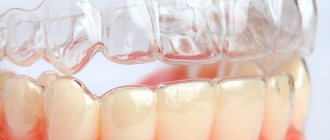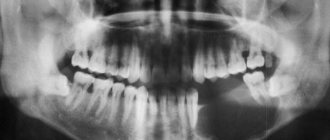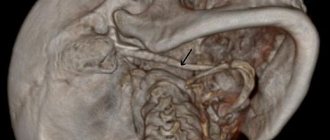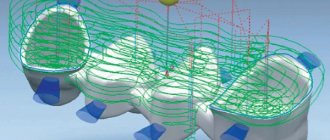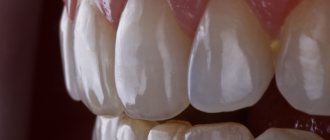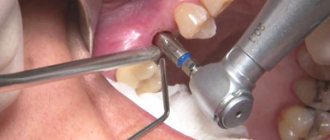01.12.2019
Single crowns and bridges are permanent prostheses that can hide significant deficiencies of natural but damaged teeth or replace their crown part. During operation, such products have their own characteristics, one of which is difficulty in washing them and surrounding tissues.
To facilitate hygienic care, the dentist makes a small temporary gap between the gum tissue and the marginal line of the crown during the prosthetic process. The prosthetic indentation is called flushing. Due to various factors, the tolerance for liquid may increase, food particles may get into it, which over time leads to complications and the development of complex diseases. About 20% of patients suffer from problems with the flushing space. What are the causes of such pathologies and how to eliminate them, we will consider in this article.
REASONS FOR THE APPEARANCE
Most often, the space between the crown and gum increases due to medical errors during prosthetics. When the prosthesis is pressed strongly against the surface of the tooth or if it is not firmly placed on the base, an unacceptable gap size appears between the gum and the masking product.
However, in some cases the problem does not arise through the fault of the doctor.
Unpleasant phenomena develop against the background of pathological processes in the patient’s oral cavity:
- Inflammation of the interdental papillae, gums and degenerative processes in the periodontal tissues. Such problems with oral health often develop when the body's protective properties are weakened, which is accompanied by allergies and inflammatory reactions to poor hygiene.
- Loss of tightness of the elements that firmly fix the removable device in the oral cavity.
- Splitting of the bridge in the area of contact with artificial crowns. If the denture has been damaged even slightly, it will inevitably change its correct position and have a detrimental effect on the tissues surrounding the tooth.
- Disintegration of a single crown. This happens if the device was installed incorrectly or when saliva gets under the crown.
- Poor oral hygiene causes inflammation of the gum tissue with swelling, which will change the size of the rinsing gap.
- Poor quality of preparation before prosthetics. Insufficient sanitation of the oral cavity, poor strength of hard and soft tissues lead to gradual destruction of the protective layer of teeth. The orthopedic device begins to settle, thereby lifting the gum above the crown.
- Periodontal disease and periodontitis. Such diseases lead to changes in the position of individual teeth, which, by their displacement, increase the size of the washing gap.
- The patient's attempts to clean the interdental space with toothpicks or other sharp objects. After such procedures, the gap between the denture and the tooth increases, food begins to get stuck and becomes a provocateur for the proliferation of pathogenic microorganisms.
- The fixing composite composition has become unusable. After the expiration of the dental cement with which the fixation was made, the crown moves away from the tooth, creating a space for food to enter. It gradually rots and thereby causes an inflammatory process.
- Excessive chewing loads on the structure. Strong pressure on the crown leads to its breakage. It happens that a tooth breaks along with the product, and it is almost impossible to save it after that.
Remember! The fit of the structure to the teeth should be optimal. That is, too tight contact or insufficient fit is unacceptable.
In the first case, such an installation can result in trauma to the tissues and mucous membranes of the mouth, in the second, the fixation of the structure is weakened, which threatens negative changes in pronunciation and difficulties in the process of eating.
Such defects very quickly disable the prosthesis without the possibility of its restoration and bringing it into working condition.
During the period of adaptation after installation of the orthopedic structure, the special gap between it and the gum should normally increase slightly. However, after 7 days of recovery, the gap width should become smaller if the patient has cared for the area properly.
Doctor's mistakes leading to loose gums
With the cement method of fixation, the following problems may occur:
- The solution gets into the space between the gum and the abutment . Fastening is accompanied by squeezing out excess solution, which neither the doctor nor the patient can control. Attempting to remove excess cement may damage the surface of the implant. The process threatens with inflammation of the bone tissue - peri-implantitis. In the worst case, loss of the structure or part of the bone tissue is possible.
- Minor errors when taking an impression and making a prosthesis . If the crown does not contact the abutment tightly enough, the cement mortar will be eroded by saliva. This will lead to the formation of soft plaque. It contains pathogenic bacteria that can cause peri-implantitis. The cemented crown will fall out.
The use of dental cement allows for the correction of errors. Screw fixation does not provide this option. Violation of the protocol for fixing the prosthesis using a screw method is fraught with rupture of the fasteners. It will need to be removed from the implant, which is not easy to do.
FIRST SIGNS
The optimal flushing gap (norm of a fraction of a millimeter), when installed correctly, ensures:
- proper fixation of the device;
- high-quality hygiene;
- protection against manifestations of pathologies of periodontal tissues;
- long-term operation of the product.
Normally, this temporary effect should not cause any complications.
You should be concerned after installing a prosthesis in the following cases:
- discomfort appears and pain occurs in certain areas of the oral cavity;
- the structure has changed its position in the mouth and this is noticeable;
- increased sensitivity of tissues and teeth to irritating foods (cold, hot, spicy, salty) and temperature changes;
- bothered by itching and burning;
- manifestations of a lisp develop;
- a whistle is heard from the mouth during a conversation;
- The general condition of the oral cavity is only getting worse every day.
The listed undesirable manifestations can be observed at the site of localization of the orthopedic product or beyond.
If the first symptoms appear, it is important to immediately seek help from a specialist.
If you have any mistrust in your dentist or orthopedist, you can get alternative advice and assistance at another medical institution.
Features of prosthetics
Even a minor foreign body in the oral cavity causes some discomfort, not to mention a full-fledged orthopedic product. The arrangement of teeth has certain characteristics.
So, about 90% of all tissues that hold the tooth in the socket have an oblique direction. It goes from the walls of the alveolar process to the root system at a certain angle.
Thus, it turns out that the tooth is, as it were, suspended on these tissues. This provides it with microexcursion and allows the enamel to withstand excessive loads. Orthopedists must take this point into account when performing various types of prosthetics.
Placement of a separate artificial crown
It is mainly used when it is impossible to restore hard tissues with filling materials, for example in the case of severe destruction of enamel and dentin. To place an artificial crown, the dentist removes a certain layer of hard tissue to the thickness of the material that will cover the tooth.
Prosthetics will take a certain amount of time. Since our body is built in a specific way, the ground tooth begins to seek contact with the antagonist.
It is as if he is tightening his height to the thickness that the doctor removed. Therefore, after fixing an artificial crown, many note certain inconveniences.
If this is associated only with a specific reaction of the periodontal ligaments, then the negative sensations disappear within 3 days. In this case, a gap may appear between the tooth and gum.
In principle, this is a natural formation called a gingival beard. But when turning the enamel, it becomes much larger.
When installing an artificial crown, its edge must be partially immersed in the anatomical formation. If the tooth appears to have “raised”, the root groove will be more pronounced.
Formation of a gap between the crown and gums in the upper jaw
At the same time, the doctor tries to avoid strong pressure on the periodontal tissue from the edge of the orthopedic structure. In this case, trophic stagnation may occur, causing diseases such as localized gingivitis and periodontitis. Therefore, the gap located between the tooth and the gum cannot be completely filled with an artificial product.
Placement of a bridge
This is a rather labor-intensive procedure that requires the manufacture of a complex structure consisting of several elements. In addition, the bridge must be placed in the oral cavity according to certain requirements.
For example, its peculiarity is that there must be a flushing space under the prosthetic bed. This is a small gap up to 3 millimeters wide.
Very often, patients complain of food retention, specifically in the area of this formation. Indeed, many people have this problem, but if pieces of food get stuck in this place in large quantities, then they speak of poor-quality manufacturing of the prosthesis, or its incorrect fit, or, much worse, the development of certain complications. You can learn how bridges are installed from the video in this article.
POSSIBLE COMPLICATIONS
If you ignore the problems that have arisen and do not visit a doctor in time for an examination, as well as to identify the causes of the gap, the patient risks encountering serious troubles and complications, namely:
- development of complex inflammation in periodontal tissues;
- sudden dismantling of the entire structure;
- destructive diseases of the units located under the crowns;
- allergy attacks to prosthetic material;
- complete breakdown of the device in the area adjacent to the crowns;
- the appearance of excessive galvanic currents in the oral cavity;
- increase in electrical conductivity of saliva;
- the appearance of signs of inflammation of the mucous membrane;
- relapses of carious processes;
- development of general symptoms of unwellness of the body;
- erosive and ulcerative lesions of the mucous membrane;
- atrophy of the tissues holding the tooth in the alveolus.
Take into account! If, after installing a crown, you are constantly bothered by painful sensations in the mouth for more than 7 days, the crown periodically moves, senesthopathy, burning, tingling in a certain area appears, the sensitivity of the teeth to irritating foods increases, you cannot do without medical help.
Moreover, the listed manifestations can be localized not only in the area of the installed device.
Another important danger that can arise after prosthetics is the penetration of the prosthesis into the digestive system after unexpected release.
Despite the fact that such products are made from non-toxic raw materials, the risk of damage to internal organs remains. Let's consider the most serious consequences, which, although rare, occur in medical practice:
- perforation of the walls of the digestive tract;
- trauma to the stomach or intestines with subsequent bleeding;
- intestinal obstruction if the swallowed product has formed an obstruction with its body.
In such cases, it is very important to immediately go to the hospital or call an ambulance. An acute clinical picture of this nature requires examination by a surgeon, gastroenterologist, or emergency transportation of the patient to the nearest emergency room.
Prosthetics with metal-ceramic crowns
These crowns are the most durable and most aesthetic material used in prosthetics. Crowns completely imitate the appearance of your teeth and restore their functions. Due to the fact that our clinic has its own laboratory, we can achieve excellent aesthetic results, and, importantly, we reduce the time required for prosthetics (on average, a metal-ceramic prosthesis for 3 units is made in 5 days). During the fabrication of the prosthesis, you use a temporary plastic prosthesis. Much depends on the mass used in the laboratory. Here we use the German Vita Omega mass, which we are 100% confident in.
ELIMINATION TACTICS
Any specialist in the dental niche, providing his services, is obliged to create an ideal fit of the orthopedic structure on the bed. That is, even if minor changes occur in the distance between the device and the working surface, the gap should remain at the optimal permissible width.
It is also important to take into account the fact that any foreign body in contact with organs and tissues of the body can initially cause discomfort, which normally can last no more than one week.
If, after this period, the body continues to signal with unpleasant symptoms, then this is a good reason to seek medical help.
If the gap between the crown and the gum has widened beyond normal limits, doctors solve the problem in the following ways:
- Local anti-inflammatory and antiseptic treatment is carried out by treating damaged areas with gels, ointments and other effective means. In this case, the structure itself is first removed from the oral cavity.
- The dental device is adjusted and adjustments are made to its parameters. If the product is unsuitable, the doctor decides to make a new design. Before this, it is important to obtain orthopantomogram data.
- The orthopedist can grind and adjust the prosthesis right in his office when the patient contacts him. All actions are performed depending on the clinical picture.
If the problem lies in the loosening of problem units, they are strengthened. After this, the prosthetics are repeated.
The rarest occurrence is the peeling of the structure when it comes to a bridge. The trouble is accompanied by a change in the position of the supporting units, which results in the need for re-prosthetics.
To avoid this, you need to go to the clinic where the installation procedure was carried out on the same day and eliminate any existing defects and defects.
Attention! Installation of crowns is permanent prosthetics. Therefore, it is not possible to simply remove the device and rinse it under clean running water or clean it using special products and return it to its place.
If the gap has increased, it means that it is urgently necessary to take measures to normalize its size.
Mechanical enlargement of the gap has one solution - reinstallation of the prosthesis. The specialist dismantles the system for correction or completely replaces it, after carrying out health measures and following a competent algorithm of actions during installation.
The shape of the crown matches the shape of the tooth
When making a crown, it is necessary to reproduce the anatomical shape of the tooth as accurately as possible. To do this, the technician draws the chewing tubercles, creates contact points and clearly draws the equator.
- The tubercles and pits on our teeth perform different functions, and each element has its own function. Some parts are designed for grinding food, others fix the correct bite or distribute the chewing load. The tubercles also ensure proper closure of the crown with the antagonist tooth located opposite it. If the closure is not tight enough, both teeth will move to the side, trying to take the correct position. Incorrect placement of the tubercles will be indicated by discomfort from the crown 2-3 weeks after installation. The doctor checks this point using a piece of special paper on which traces remain. This is also why temporary crowns are used, a kind of test drive.
- Equator. We are talking about a thickening, thanks to which food does not fall on the gums, but slides inside the oral cavity, as if down a slide. If the equator on the new crown is flat, then food particles will fall into the periodontal sulcus, which will lead to inflammation and discomfort. Contact point. This refers to the point at which adjacent teeth meet. It must be present, otherwise an interdental gap will form into which pieces of food will get clogged. Inflammation of the corresponding area of the gum may also appear. To test, take dental floss and pull it between your teeth. If you hear a click, there is a contact point.
PREVENTION MEASURES
To prevent problems with the crown from occurring, the patient must strictly follow the medical recommendations that are communicated to him immediately after the prosthetic procedure:
- perform high-quality hygienic care for the product, organs and tissues of the oral cavity at least 2 times a day;
- Use herbal rinses and dental hygiene devices for additional cleansing 3 times a week;
- periodically visit the attending physician for a preventive examination, monitoring the condition of the structure, and its professional cleansing of food particles;
- use a special dental brush to remove the smallest food residues after each meal;
- use wound-healing pastes for prevention if the slightest discomfort occurs (especially during the period of adaptation);
- purchase an adhesive base to cover the space between the crown and gum tissue (only on the advice of a doctor);
- use a special mouth guard with a cleaning agent, which is placed in the area of the prosthesis to lighten its shade and provide antiseptic treatment;
- limit or completely eliminate coarse salt, poppy seeds, shortcrust pastries, crackers from the diet;
- come to the clinic in a timely manner to make adjustments to the parameters of the orthopedic product in order to prevent the risk of device displacement and widening of the irrigation gap.
Forbidden:
- use a stiff toothbrush;
- apply floss around the neck of the tooth with a crown installed (an irrigator is recommended to clean such places);
- use hard and sharp auxiliary tools (match, needle, sliver, etc.).
Preventive measures must be carried out conscientiously by the patient. Not only the health of the oral cavity and the body as a whole, but also the lifespan of the crown will depend on the quality of care.
Category: Tooth extraction Published by Mister stomatolog
Preventive crown care
In order not to provoke the accumulation of masses under the crown and cause tooth decay, it is necessary to maintain oral hygiene. A crown is an artificial structure and will require more care.
- Brush your teeth twice a day, including using special brushes for caring for dentures.
- Rinse your mouth after every meal.
- Floss regularly.
- Use toothpicks only when necessary. This is not at all a means of maintaining dental hygiene! Picking with a wooden stick, expanding cavities in teeth and crowns, is contraindicated.
If you have already had the sad experience of tooth decay under a denture, pay more attention to the alarm bells: pain under the crown, bad smell, taste of blood in your mouth. Make an appointment with a dentist; timely treatment will be shorter and cheaper than treatment for a neglected tooth.
If you realize that the tooth has begun to rot, remember that the process is irreversible. It will not be possible to cure inflammation with home methods. You should not wait until there is severe pain or the crown falls out in your sleep, with the risk of suffocation. A diagnosis from a doctor will help you cope with the problem.
Make an appointment at Dr. Lopaeva's clinic
Make an appointment
Or call +7(985)532-21-01

